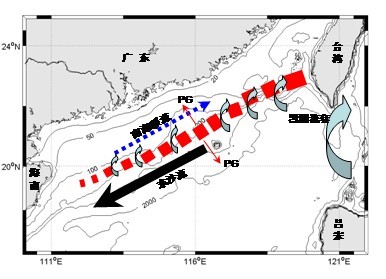Important Progress in the mechanism of the formation of the South China Sea Warm Current
The Key Laboratory of Tropical Marine Environmental Dynamics (LED), South China Sea Institute of Oceanology (SCSIO), Chinese Academy of Sciences (CAS) has recently made important progress in studying the mechanism of the ‘South China Sea Warm Current (SCSWC)’.
Previous observation data by SCSIO show that there is a warm current against the northeast winter monsoon wind, and it is named as ‘South China Sea Warm Current (SCSWC)’. It is generally believed that the SCSWC is originated from the east of the Hainan Island, and it passes through the northern SCS continental shelf, at last flows into the shelf region in the East China Sea through Taiwan Strait. The forming mechanism of SCSWC is always a hot and difficult topic for studying the SCS circulation. Working together with the Hong Kong University of Science and Technology, Dongxiao Wang’s Group have obtained a new theory on the forming mechanism of the SCSWC by utilizing the Princeton Ocean Model (POM). They found that the Joint Effect of Baroclinicity and Relief (JEBAR) is important for the SCSWC. The JEBAR term induces the cross-shelf transport at the edge of the northern SCS continental shelf, and provides important momentum source for the SCSWC. The pressure gradient at the shelf break caused by the Kuroshio intrusion from the Luzon Strait is thus an important constraint for the SCSWC.
This research work is accepted by the Deep Sea Research I (IF: 2.593) recently, and will be published in October, and this work is supported by the found from CAS and NSFC.

